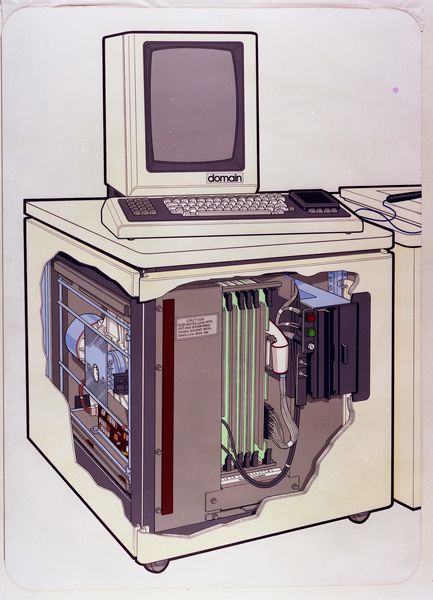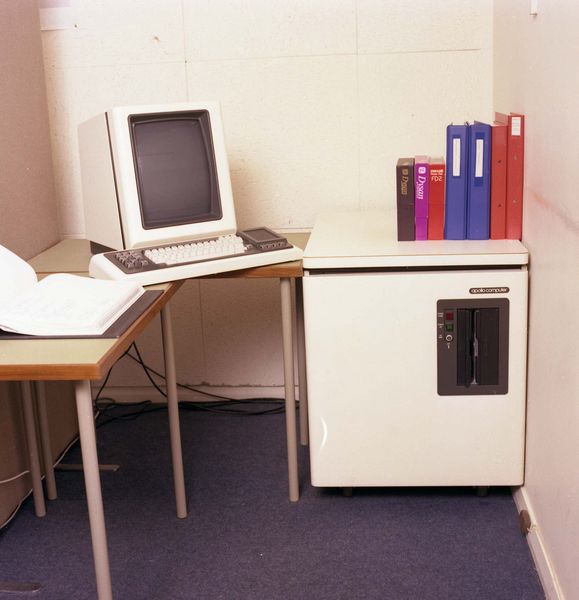

ICL started 1982 with no competitors to the PERQ. The only company other than ICL in the same price/performance bracket was Apollo with an inferior product at a higher price but with a reasonable portfolio of applications software.
The year 1982 was the one when other companies entered the field and the struggle for ascendancy in this market place really started.
The main competition was likely to be Apollo and SUN.
In the period 1980-81, some systems designers at Stanford University in California had developed a hardware design for the processor/memory of a high powered single user system on similar lines to the PERQ but based on the 68000 microprocessor rather than bit slice technology. The main people involved in the design were Forest Baskett and Andy Bechtolscheim. It was possible to licence this hardware design from Stanford, and established CAD vendors such as CADLINK and Forward Technology did this, producing systems aimed at particular CAD markets.
In the same period, Berkeley University had done a number of developments on the UNIX operating system to provide additional functionality and improved performance. The main architect of this work was Bill Joy. Although most of the Berkeley developments had been done on VAX computers, some had been ported to 68000 based systems.
In February 1982, Andy Bechtolsheim and Bill Joy were amongst the people who started a new company, SUN Microsystems Ltd, to produce a 68000-based UNIX workstation at low cost and high performance. Associated with the company but remaining at Stanford University was Jim Clarke who had designed a geometry chip which provided high powered graphics both in 3D transformations and rendering.
By March 1982, SUN had announced their first product, the SUN-1, with a basic price of $8,900. They were prepared to quote delivery times of 90 days and would have Berkeley UNIX available at that time. If these timescales could be met, SUN would be in advance of ICL, having started at least 6 months later. The reason for this was due to the development work already done at Stanford and Berkeley. Effectively the company was planning to productise the already developed system.
The initial SUN system had an ethernet connection running at both 3 MHz and 10 MHz. Both were non-standard.
The company proposed to bring out an add-on colour display as well over the next few months.
Jim Clarke was installing his geometry chips into a SUN workstation and believed he would get significant performance advantages over any other system on the market. As a system for, say, molecule rotation, it would be very impressive.
Bob Hopgood talked to Jim Clarke in March 1982 and suggested that he should let RAL have a pre-production system for evaluation. Eventually, because of SERC's strong connection with ICL, he refused.
During the summer of 1982, both George Coulouris and Bob Hopgood looked at SUN systems in more detail. At SIGGRAPH 82, SUN demonstrated both a black and white system and one with an attached colour display. By now, everybody in the USA was gravitating towards Berkeley 4.2 UNIX and the SUN had a distinct edge in being able to offer a working virtual memory UNIX system.
However, the system demonstrated at SIGGRAPH in August was a Version 7 UNIX with no virtual memory and was equivalent to the port that had been done by HCR on the PERQ. It performed better than the HCR implementation because of the better match between the C-output and the architecture of the 68000.
In discussing the price with SUN, it turned out to be a lot less attractive. The real price of a system comparable to the 1 Mbyte PERQ was over $30,000 and it was inferior to the PERQ in a number of areas. The resolution of the display was significantly worse, the UNIX performance was not particularly fast, the ability to move information on the display was decidedly worse.
In August 1982, George Coulouris visited SUN and did some benchmarking. The basic machine performance varied between 0.1 and 2.4 times a VAX 11/750. Floating point speeds were slow, the memory configuration with on-board cpu memory and a separate memory board caused problems. The rasterop hardware was driven by the processor and could not support a sophisticated window manager as well as doing any processing. Bob Newman, later to start Whitechapel, was involved in this assessment.
The SUN1 did not appear to be a real threat to the PERQ. However, the company was planning a SUN2 which would have better floating point, Berkeley 4.2 UNIX, paging hardware and be available by the summer of 1983. ICL needed to be in a similar position by then.
Many universities ordered SUN1s. They were late in delivery and there were significant problems with reliability, performance and support. With hindsight, the decision not to purchase SUN systems for evaluation in 1982 turned out to be a good one. We would have encountered many of the problems, or similar ones, to those encountered on the PERQ.
We had purchased our first Apollo in October 1980 at a cost of $40,000. It was delivered on 24 June 1981. It was only 2 months late from the original delivery date.
The original green on black 30 Hz system was awful. Consequently, when Apollo announced a 60 Hz black and white system, we upgraded the original system at an additional cost of £1,500. This was ordered late in 1981 for delivery before March 1982.


An initial worry with the first system was the maintenance cost which was over twice that of the PERQ. With the number of systems we had at that time, if we had gone with Apollo, the maintenance costs would have been greater by somewhere between £100K and £200K per annum.
The original system came with a FORTRAN compiler and by November 1981, a PASCAL compiler had been added.
The black and white system arrived in March 1982 and was a considerable improvement over the green on black system. Even so, its graphics capability was worse than the PERQ.
During 1982, Apollo made headway in getting applications software on to the system. At CAD'82, ROMULUS was demonstrated and a whole spectrum of CAD software was available. Most of the software was a straight port which, on closer inspection, used none of the facilities of the single user system.
By May 1982, Apollo had sold 10 systems in the UK compared with the 150 or so sold by ICL.
By July 1982, Apollo had decided that there was a need to have UNIX on the system as well as their proprietary AEGIS operating system. This would be released later in the year. In July, Apollo demonstrated their colour system at SIGGRAPH and it was very impressive. Most of the faults with the black and white system had been cured. Rasterop hardware had been added. However, at a cost of nearly £58K, it was significantly more expensive than the PERQs which we were buying at around £20K.
By September 1982, Apollo were pressuring SERC's Science Board directly to purchase Apollo systems. They said their systems embraced all the features in the SERC's Common Base Policy and believed that they should be given the opportunity to propose solutions based on their DOMAIN architecture running AEGIS rather than UNIX. RAL does not have details of what correspondence took place between the Science Board and Apollo.
In November 1982, Version 4.1 of the Apollo software system was installed and assessed. Apart from not supporting UNIX or GKS, it fulfilled most of the requirements of the SERC Common Software Base.
Benchmarking this system showed it was performing at somewhere between 10 and 20% of a VAX 11/780 on CAD applications. Considering its price, it was not an effective competitor to a VAX or PRIME system for heavy computational programs. As with SUN, the manufacturer's performance claims were not seen in local benchmarking.
Assessments of the code produced by the FORTRAN compiler were made and it was clear that almost no optimisation was being done.
In summary, by the end of 1982, Apollo had made significant advances from their earlier models. The colour DN600 system was particularly impressive. However, their systems were very expensive and not a real direct competitor to the PERQ at that time.
By the end of 1982, Apollo had 427 employees (compared with 250 in ICL/Three Rivers) and had shipped of the order of 500 systems (compared with over 1,000 PERQs).
At the December 1982 meeting of the SUSSG, the draft operational requirement had a list of potential suppliers attached to it. During 1982, we had made contact with 51 companies who had announced products in 1982 which in some way rivalled the PERQ.
The clear lead that ICL and Three Rivers had in the market had been completely eroded over the period 1981/2.